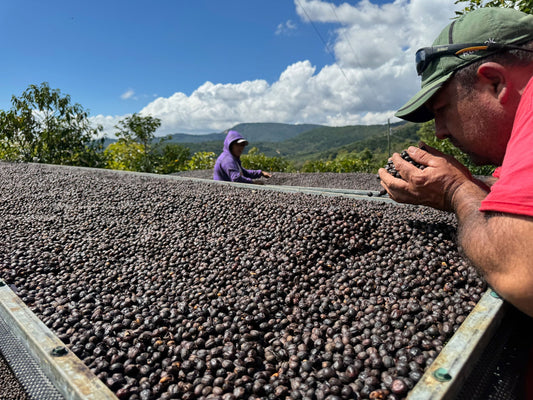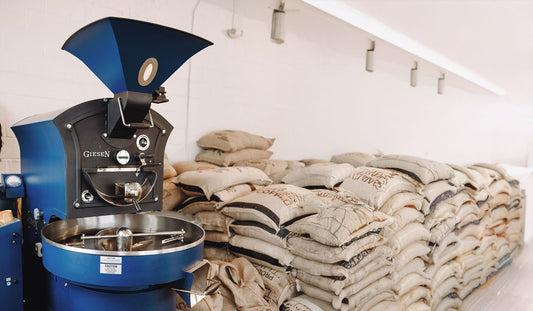ARABICA (Coffea arabica)
Taste Profile: Arabica coffee is known for its smooth, complex flavor profiles, making it the most common choice in the specialty coffee world.
Unique Attributes: Arabica's self-pollinating nature ensures a consistent flavor profile over generations, which is a highly valued trait by producers. This species prefers the cooler climates and higher elevations of mountainous regions, which contribute to its slower and sweeter development.
Growing Conditions: Optimal growth occurs at altitudes of 1200-2200 meters, with temperatures between 15-24°C, and annual rainfall of 1200-2200mm. Well-drained, slightly acidic soil is ideal for its quality and flavor.
Yield: On average, Arabica farms produce 1-1.5 tons of coffee per hectare - quality over quantity.
Sustainability: The “shade-grown” coffee practice not only supports a diverse ecosystem but also improves the quality. However, Arabica's susceptibility to diseases like coffee leaf rust requires careful management and sustainable farming practices to ensure crop health and productivity.
Market Insights: Arabica beans fetch higher prices in the specialty coffee market, reflecting their superior flavor and quality. The demand for single-origin Arabica coffee has surged, highlighting the importance of sustainable and ethical sourcing practices.
Varieties: Popular Arabica varieties include Typica, Bourbon, Geisha, Caturra, and Catuai, each offering a distinct flavor profile influenced by their growing conditions.
ROBUSTA (Coffea canephora)
Taste Profile: Known for its bold, robust flavor, Robusta packs the highest caffeine content of all common coffee species. Its strong (often bitter tasting) and full body make it a popular choice for use in espresso blends by many brands.
Unique Attributes: Robusta's resilience to pests and diseases, along with its ability to thrive at lower altitudes, make it a sturdy option for coffee farmers. This species can also deliver a reliable yield year after year, all which is great for mass production.
Growing Conditions: Thriving in warmer climates, Robusta prefers altitudes below 800 meters (significantly lower than Arabia), with annual rainfall requirements of 2200-3000mm (significantly higher than Arabica) and temperatures ranging from 24-30°C.
Yield: Robusta plants are high yielders, producing up to 2.5-3 tons per hectare!
Sustainability: Robusta's natural resistance to diseases reduces the need for chemical pesticides, supporting more sustainable cultivation practices. Its adaptability to warmer climates makes it a contender for future-proofing coffee agriculture against climate change.
Market Insights: Even though it is generally valued lower than Arabica, Robusta's role in espresso blends and instant coffee has solidified its place in the global coffee market. However, experiments and innovations in cultivation and processing are beginning to yield higher-quality Robusta coffees, which may broaden its appeal even further.
Varieties: Notable Robusta varieties include Conilon and Kouilou, each adapted to specific environmental conditions and offering unique cup-characteristics.
LIBERICA & EXELSA
Taste Profile: Liberica beans are known for their distinctive fruity and floral flavors, accompanied by a bold, somewhat smoky finish. Excelsa, which is often considered a variant of Liberica, has a tart, fruity taste with a lighter body, which helps add complexity to coffee blends.
Growing Conditions: Both species are adaptable to a range of environments but perform best in conditions similar to Robusta. Liberica favors a slightly higher altitude up to 900 meters.
Yield and Sustainability: While yields are generally lower than Arabica and Robusta, the hardiness of Liberica and Excelsa contributes to biodiversity and offers alternatives for regions affected by climate change or disease pressures on usual coffee crops.
Market Insights: Liberica and Excelsa coffees are often marketed as specialty products, where their unique flavors can go for higher prices and appeal to specific coffee markets.
HYBRIDS
Coffee hybrids (like Catimor and Sarchimor) are bred to combine the most desirable traits of Arabica and Robusta, such as disease resistance, yield efficiency, and flavor. These hybrids are crucial in addressing the climate change issues, disease, and the need for sustainable coffee production and consumption practices.
Taste Profile: Hybrids are designed to offer the best of both worlds, where some mimicking the delicate flavors of Arabica, while others can help elevate the boldness of a coffee using Robusta.
Growing Conditions: Hybrids are made to be versatile, so crops can flourish across a range of altitudes and climates. This makes them valuable assets in the global effort to sustain coffee production, amidst problems posed by climate change.
Sustainability: The development of disease-resistant and climate-adaptable hybrids is a significant advancement in sustainable coffee farming. Hybrids hold the potential to reduce dependency on chemicals and fertilizers.
Market Insights: As the quality of hybrid coffees continues to improve, Hybrids are carving out their space in both the specialty and commodity coffee markets, offering new opportunities for farmers to balance sustainability with economic viability.



